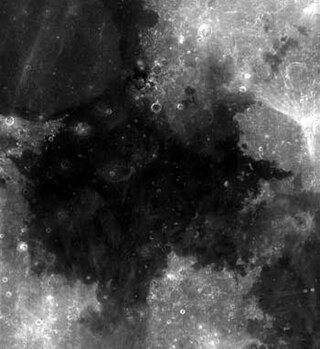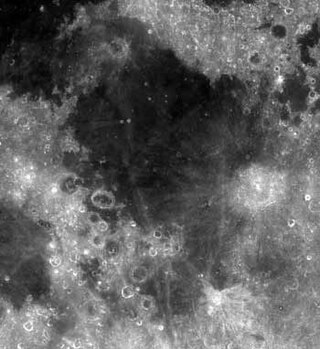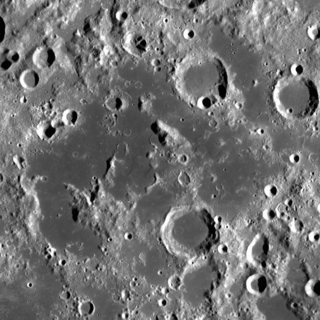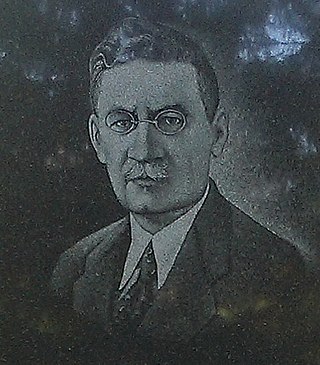
Mare Humorum is a lunar mare. The impact basin it is located in is 425 kilometers (264 mi) across.

Mare Anguis is a lunar mare located on the near side of the Moon, about 150 kilometers in diameter. Located within the Crisium basin, Mare Anguis is a part of the Nectarian System, meaning that it was formed during the Nectarian time period. Like most mare, the surface of Mare Anguis is dark, indicating that it has been filled with volcanic basalt. It forms part of a concentric ring to the northeast of the Crisium rim, and it lies at an elevation 800 m above Mare Crisium. Channels lead down from Mare Anguis to Mare Chrisium, with some possible indications of lava flow.

Mare Crisium is a lunar mare located in the Moon's Crisium basin, just northeast of Mare Tranquillitatis. Mare Crisium is a basin of Nectarian age.

Mare Tranquillitatis is a lunar mare that sits within the Tranquillitatis basin on the Moon. It is the first location on another celestial body to be visited by humans.

Mare Fecunditatis is a lunar mare in the eastern half of the visible Moon. The mare has a maximum diameter of 840 km.

Mare Spumans is a lunar mare located just south of Mare Undarum on the lunar near side. It is one of the many elevated lakes contained in the Crisium basin, surrounding Mare Crisium. The surrounding basin material is of the Nectarian epoch, while the mare basalt being of the Upper Imbrian epoch. The crater Petit is located on the western rim of the mare. This crater is white and surrounded by a well-defined ray system.

Mare Undarum is a shallow, irregular lunar mare located just north of Mare Spumans on the lunar near side, between the crater Firmicus and the eastern limb. It lies within a trough between the third and fourth raised rings formed by the impact that created the Mare Crisium. The selenographic coordinates of this mare are 7.5° N, 68.7° E. It has a maximum diameter of 245 km.

Montes Haemus is a mountain range that forms the southwestern edge of the Mare Serenitatis basin on the Moon. They form a less prominent mirror image of the Montes Apenninus range to the west, and curve up to nearly join at the northern end. The eastern edge terminates with the Promontorium Archerusia, to the northwest of the crater Plinius. This end reaches a gap where the Mare Serenitatis to the north joins the Mare Tranquillitatis to the south.

Fahrenheit is a tiny lunar impact crater located in the southeast part of the Mare Crisium. This area of the surface is nearly devoid of impact features of interest. To the east are the Dorsa Harker wrinkle ridges, and beyond them is Promontorium Agarum at the edge of the mare. The landing site of the Soviet Luna 24 probe is located about 15 kilometers to the southeast.

Cleomedes is a prominent lunar impact crater located in the northeast part of the visible Moon, to the north of Mare Crisium. It was named after Greek astronomer Cleomedes. It is surrounded by rough ground with multiple crater impacts. The irregular crater Tralles intrudes into the northwest rim. To the east is Delmotte. North of Cleomedes is a triple-crater formation with Burckhardt occupying the center.

Auzout is a lunar impact crater that is located to the southeast of the Mare Crisium, near the eastern limb of the Moon. It is named after French astronomer Adrien Auzout."Auzout (crater)". Gazetteer of Planetary Nomenclature. USGS Astrogeology Research Program. Attached to the southern rim is the smaller crater van Albada. To the east-northeast is the large Condorcet. This crater is not especially notable, although it does possess a central mountain. This crater is designated 'Azout' in some sources.

Montes Alpes is a mountain range in the northern part of the Moon's near side. It was named after the Alps in Europe; the name was confirmed by the International Astronomical Union in 1935. It lies between the selenographic coordinates latitudes 52.81°N and 42.04°N, and longitudes 5.6°W and 3.22°E. The range thus crosses the lunar prime meridian, and is partially illuminated and partially in shadow during first and last quarters. The center of the range is at 48.36°N, 0.58°W, and has a diameter of 334 km.

Eckert is a tiny, isolated lunar impact crater in the northern part of the Mare Crisium. This crater forms a circular pit in the dark surface of the surrounding lunar mare. Just to the west is a wrinkle ridge in the mare surface, a feature that is prominent only under oblique lighting from the Sun. The nearest craters of note are Peirce to the west-northwest, and Picard to the southwest. Both of these craters lie in the Mare Crisium basin.

Selenography is the study of the surface and physical features of the Moon. Like geography and areography, selenography is a subdiscipline within the field of planetary science. Historically, the principal concern of selenographists was the mapping and naming of the lunar terrane identifying maria, craters, mountain ranges, and other various features. This task was largely finished when high resolution images of the near and far sides of the Moon were obtained by orbiting spacecraft during the early space era. Nevertheless, some regions of the Moon remain poorly imaged and the exact locations of many features are uncertain by several kilometers. Today, selenography is considered to be a subdiscipline of selenology, which itself is most often referred to as simply "lunar science." The word selenography is derived from the Greek word Σελήνη and γράφω graphō, meaning to write.

Sobkou Planitia is a large basin on the planet Mercury. It is named after the ancient Egyptian messenger deity Sobkou. He was associated by the Egyptians with the planet Mercury.

Mikhail Antonovich Usov was a Russian and Soviet geologist and member of the Academy of Sciences of the USSR. He was the first native of Siberia to be elected.

Lev is a tiny lunar crater located in the southeast part of the Mare Crisium in the east of the lunar near side. The crater is located between the larger crater Fahrenheit to the northwest and the wrinkle ridge Dorsa Harker to the southeast. The name Lev does not refer to a specific person; it is a Russian male given name. Northwest of the crater was the Luna 24 landing site.

Volcanism on the Moon is represented by the presence of volcanoes, pyroclastic deposits and vast lava plains on the lunar surface. The volcanoes are typically in the form of small domes and cones that form large volcanic complexes and isolated edifices. Calderas, large-scale collapse features generally formed late in a volcanic eruptive episode, are exceptionally rare on the Moon. Lunar pyroclastic deposits are the result of lava fountain eruptions from volatile-laden basaltic magmas rapidly ascending from deep mantle sources and erupting as a spray of magma, forming tiny glass beads. However, pyroclastic deposits formed by less common non-basaltic explosive eruptions are also thought to exist on the Moon. Lunar lava plains cover large swaths of the Moon's surface and consist mainly of voluminous basaltic flows. They contain a number of volcanic features related to the cooling of lava, including lava tubes, rilles and wrinkle ridges.

Mons Latreille is a solitary lunar mountain in central Mare Crisium. This feature was named by the IAU in May 2021, after Pierre André Latreille, a French entomologist. It rises approximately 150 m above the surrounding mare, and it is approximately 6.4 km in diameter.



















